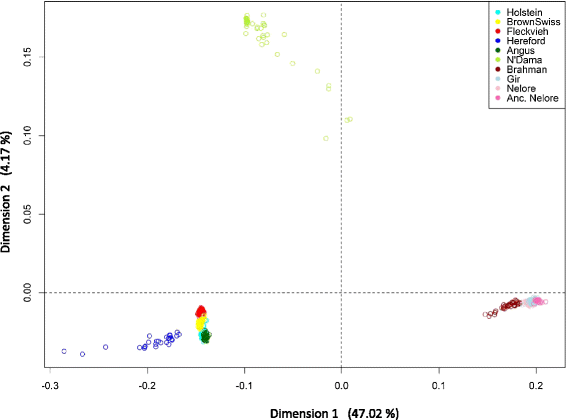Low levels of taurine introgression in the current Brazilian Nelore and Gir indicine cattle populations
- PMID: 25928250
- PMCID: PMC4404172
- DOI: 10.1186/s12711-015-0109-5
Low levels of taurine introgression in the current Brazilian Nelore and Gir indicine cattle populations
Abstract
Background: Nelore and Gir are the two most important indicine cattle breeds for production of beef and milk in Brazil. Historical records state that these breeds were introduced in Brazil from the Indian subcontinent, crossed to local taurine cattle in order to quickly increase the population size, and then backcrossed to the original breeds to recover indicine adaptive and productive traits. Previous investigations based on sparse DNA markers detected taurine admixture in these breeds. High-density genome-wide analyses can provide high-resolution information on the genetic composition of current Nelore and Gir populations, estimate more precisely the levels and nature of taurine introgression, and shed light on their history and the strategies that were used to expand these breeds.
Results: We used the high-density Illumina BovineHD BeadChip with more than 777 K single nucleotide polymorphisms (SNPs) that were reduced to 697 115 after quality control filtering to investigate the structure of Nelore and Gir populations and seven other worldwide populations for comparison. Multidimensional scaling and model-based ancestry estimation clearly separated the indicine, European taurine and African taurine ancestries. The average level of taurine introgression in the autosomal genome of Nelore and Gir breeds was less than 1% but was 9% for the Brahman breed. Analyses based on the mitochondrial SNPs present in the Illumina BovineHD BeadChip did not clearly differentiate taurine and indicine haplotype groupings.
Conclusions: The low level of taurine ancestry observed for both Nelore and Gir breeds confirms the historical records of crossbreeding and supports a strong directional selection against taurine haplotypes via backcrossing. Random sampling in production herds across the country and subsequent genotyping would be useful for a more complete view of the admixture levels in the commercial Nelore and Gir populations.
Figures


References
-
- FAO - Food and Agriculture Organization of the United Nations, FAOSTAT. 2012. http://faostat3.fao.org/. Accessed 11 March 2014.
-
- IBGE - Instituto Brasileiro de Geografia e Estatística: Pesquisa Pecuária Municipal. 2012. http://www.sidra.ibge.gov.br/bda/pecua/default.asp?t=2&z=t&o=24&u1=1&u2=.... Accessed 11 March 2014.
-
- ABCZ - Associação Brasileira dos Criadores de Zebu: Pecuária Brasileira - Produção a pasto.2012. http://issuu.com/revista_abcz/docs/documento_abcz_pecuariabrasileira. Accessed 11 March 2014.
-
- FAO - Food and Agriculture Organization of the United Nations, Food Outlook Global Market Analysis. 2012. http://www.fao.org/docrep/016/al993e/al993e00.pdf. Accessed 11 March 2014.
Publication types
MeSH terms
LinkOut - more resources
Full Text Sources
Other Literature Sources

